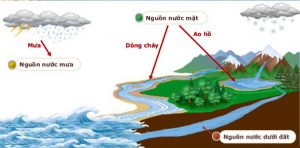Potentially toxic chemicals called PFAS (perfluoroalkyl and polyfluoroalkyl substances) are found in surface and groundwaters around the world at levels much higher than many international regulators allow, a new study found.
Called “forever chemicals” because they fail to break down fully in the environment, PFAS have been used since the 1950s to make consumer products nonstick, oil- and water-repellent and resistant to temperature change.
Even in locations with no known source of contamination, 31% of ground water samples exceeded threshold limits proposed in March 2023 by the US Environmental Protection Agency, according to the study, and nearly 70% exceeded standards set by Health Canada.
The EPA proposal, soon expected to be finalized, set a specific limit of 4 parts per trillion for two older legacy chemicals, perfluorooctane sulfonic acid (PFOS) and perfluorooctanoic acid (PFOA), while also setting new limits for a mixture of four chemicals developed by industry to replace them.
Some of the most studied PFAS, such as PFOA and PFOS, have been linked to serious health problems such as cancer, obesity, thyroid disease, high cholesterol, decreased fertility, liver damage and hormone disruption, according to the EPA.
Exposure to PFAS is associated with decreased infant and fetal growth as well as decreased antibody response to vaccines in both adults and children, according to a 300-plus-page report released in July 2022 by the prestigious National Academies of Sciences, Engineering, and Medicine.
Studies are now finding the same health impacts from some of the newer PFAS versions, according to the report, which called for people at higher risk, such as pregnant women, young children and the elderly, to be tested for a subset of PFAS chemicals.
“The significance of this (new) paper is highlighting the failure of chemical policy and allowing widespread release of PFAS to the extent that they have been dispersed across the globe to contaminate water everywhere,” said David Andrews, a senior scientist for the Environmental Working Group, a consumer organization that monitors exposure to PFAS and other chemicals.
“These contaminants have been found in the Arctic, on the slopes of Mount Everest, in penguins, polar bears, whales and seals,” said Andrews, who was not involved in the new study. “These are chemicals that are just incredibly ubiquitous around the globe because of their release by manufacturers and how they have spread into the soil, air and water.”
Since most PFAS sampling done so far has been in developed countries and locations where academic researchers are concentrated, “if we were to test more broadly, we would find even more exposure,” Andrews added.
Dangers of PFAS
Various PFAS chemicals have been detected in the blood of 98% of Americans and can be stored for years in different organs in the body, according to the report by the National Academies of Sciences, Engineering, and Medicine.
However, drinking water may only be responsible for about 20% of exposure, with the most significant exposures coming from food, dust and other sources, Andrews said.
That’s because they have been used for decades in thousands of consumer products, including food packaging designed to prevent grease and water from soaking through food wrappers and beverage cups. The chemicals are also used to make carpeting, clothing and furniture resistant to stains, water and grease damage. Other uses include nonstick cookware, cell phones, commercial aircraft and low-emission vehicles.
Public concern led to a commitment by manufacturers in 2008 to phase out use of PFOA and PFOS, two of the most widely used chemicals. However, “as PFOS and PFOA are phased out and replaced, people may be exposed to other PFAS,” the Agency for Toxic Substances and Disease Registry noted on its website.
In addition, health advisories issued in June 2023 by the EPA found certain PFAS chemicals are even more hazardous to human health than scientists originally thought, at levels thousands of times lower than previously believed.
Only a few PFAS have been studied
The study, published Monday in the journal Nature Geoscience, collated and analyzed available data from more than 45,000 water samples gathered around the world since 2004.
“There can be quite a few sources to the environment, including fire-fighting training centres that used extensive amounts of foams to practice putting out fires (and therefore save lives), landfills, industries that have used PFAS in their products, factories that made PFAS and wastewater treatment plants (sewage treatment plants),” said lead study author Denis O’Connell, a professor in the school of civil and environmental engineering, at the University of New South Wales in Sydney, in an email.
Generally PFAS concentrations are higher in urban areas or areas that used PFAS products extensively, O’Connell said, but it is also leached into the environment in ways that may not be obvious.
“Another example is that PFAS used to be used in ski wax, so pristine environments, where people ski, have PFAS in their waters and soils,” he said.
There are more than 14,000 distinct types of PFAS, but only a few undergo routine testing in water, O’Connell said. That’s another reason the extent of the pollution and subsequent potential harm to human health may be much more extensive than currently known.
“We only know the health impacts of a few PFAS, so more work is required to determine health and ecosystem impacts of a range of PFAS,” O’Connell said.
Filtering water can help
Many treatment plants in major cities already filter for PFAS, and with the new EPA guidelines, more will be required to do so within the next three years. However, about 15% of the US population, or more than 43 million people, use well water, which is not federally regulated, according to the US Geological Survey.
Anyone who is concerned about their water can purchase a test online or from a certified lab, Andrews told CNN in a prior interview.
“The most important thing is to ensure the testing method can detect down to at least four parts per trillion or lower of PFAS,” he said. “There are a large number of labs across the country certified to test to that level, so there are a lot of options available.”
If levels are concerning, consumers can purchase a water filter for their tap. NSF, formerly the National Sanitation Foundation, has a list of recommended filters.
“The water filters that are most effective for PFAS are reverse osmosis filters, which are more expensive, about in the $200 range,” Andrews said. Reverse osmosis filters can remove a wide range of contaminants, including dissolved solids, by forcing water through various filters.
Granular activated carbon filters are more common and less expensive but not quite as effective or consistent for PFAS, he added.
“The important part is that you have to keep changing those filters,” he said. “If you don’t change that filter, and it becomes saturated, the levels of PFAS in the filtered water can actually be above the levels in the tap water.”
Detail: https://amp-cnn-com.cdn.ampproject.org/c/s/amp.cnn.com/cnn/2024/04/08/health/pfas-groundwater-global-contamination-scn-wellness




